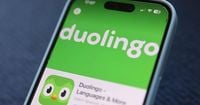Duolingo, the popular language-learning app, is making a bold move to become an "AI-first" company, a transition that will see it gradually replace human contractors with artificial intelligence. This strategic pivot, announced by CEO Luis von Ahn in an internal memo shared on LinkedIn, is designed to enhance productivity and scalability within the company.
In his memo, von Ahn stated that Duolingo will "gradually stop using contractors to do work that AI can handle." This decision reflects a growing trend in the tech industry where companies are increasingly relying on AI to streamline operations and reduce manual tasks. By implementing AI, Duolingo aims to produce the massive amount of content necessary for its platform more efficiently, as creating content manually could take decades.
To facilitate this transition, the company will evaluate job candidates and employee performance based on their proficiency with AI tools. Von Ahn emphasized that headcount increases will only be considered when teams can no longer automate their work effectively. "Being AI-first means we will need to rethink much of how we work," he wrote. "Making minor tweaks to systems designed for humans won’t get us there." This marks a significant shift in how Duolingo operates, as it seeks to embed AI into most business functions.
The company’s commitment to an AI-first approach is not entirely new; Duolingo has been utilizing AI for some time, particularly in features such as AI-generated pronunciations for languages like Irish. Users have previously noted that the voices for certain languages appeared to be computer-generated, raising concerns about the quality of AI-generated content.
Von Ahn acknowledged that while the company will not wait for AI technology to be "100 percent perfect," it is prepared to accept occasional "small hits on quality" in the interest of moving quickly. "We'd rather move with urgency and take occasional small hits on quality than move slowly and miss the moment," he stated. This approach mirrors the company’s earlier decision to embrace mobile technology, which ultimately paid off when Duolingo was named Apple’s iPhone App of the Year in 2013.
As part of the AI-first strategy, Duolingo will also implement what von Ahn referred to as "constructive constraints" to encourage teams to prioritize automation before seeking additional resources. This policy aligns with similar directives from other tech leaders, such as Shopify's CEO, who has urged employees to maximize AI use before requesting new hires.
Despite the significant changes, Duolingo insists that its focus on employee well-being will remain a priority. The company plans to support its staff through training, mentorship, and tools to help them adapt to new workflows. Von Ahn reassured employees that the goal is not to replace workers with AI but to alleviate bottlenecks and allow them to focus on more complex and creative tasks.
With over 500 million registered users, Duolingo has experienced explosive growth since going public four years ago. The company’s paid subscriber count surged from just under 2 million in 2021 to over 8 million in 2024, showcasing the demand for its language-learning services. However, as the company integrates AI into its operations, it must navigate the potential pitfalls of relying heavily on technology that is still evolving.
Critics have raised concerns about the implications of such a shift. While AI has the potential to enhance efficiency, there are questions about the quality of the content produced and the impact on the workforce. A recent study indicated that the actual time savings from AI tools were far less than anticipated, suggesting that the promised benefits may not materialize as expected. Users reported only a 2.8 percent reduction in work hours, raising doubts about whether Duolingo's push for AI is ultimately beneficial for its employees.
As Duolingo embarks on this ambitious journey, the company recognizes that not all systems are ready for immediate automation. Von Ahn noted that integrating AI into specific areas, such as codebase analysis, could take longer than anticipated. Nevertheless, he remains optimistic about the potential of AI to transform the language-learning landscape.
In summary, Duolingo’s shift to an AI-first model represents a significant transformation in the way the company operates. By prioritizing AI, Duolingo aims to enhance its content creation capabilities and streamline processes, but it must also address the challenges and uncertainties that come with such a profound change. As the tech industry continues to evolve, Duolingo’s approach may serve as a blueprint for other companies looking to navigate the complexities of integrating AI into their operations.



